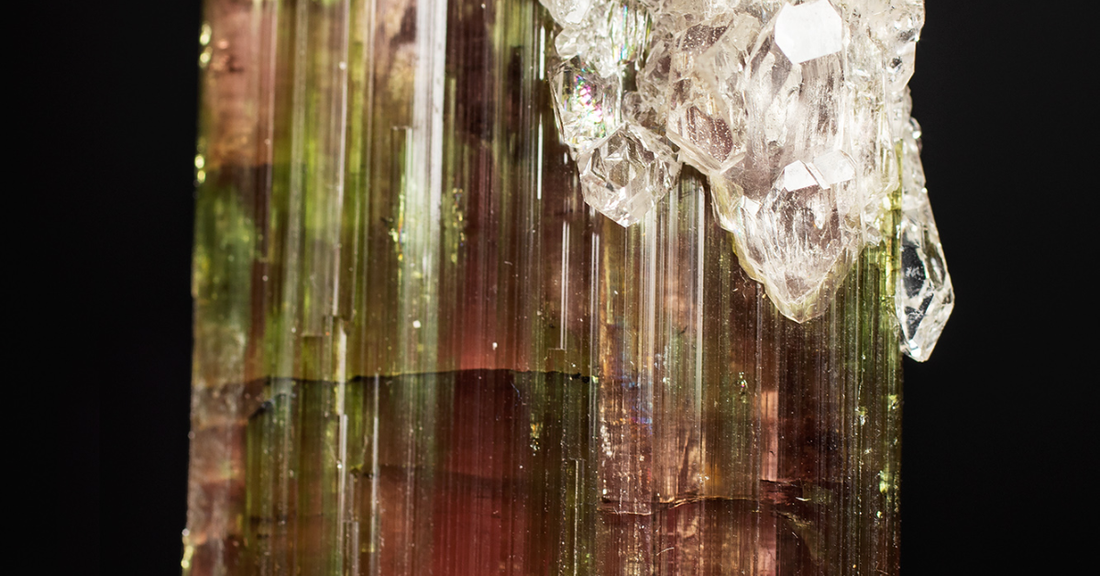
Tourmaline (What is it? Formation and Where to Buy)
Share
Tourmaline is one of the most fascinating and diverse gemstones in the world. Its wide colour range and rich history make it a favourite for collectors, jewellers, and crystal enthusiasts. But many people who hear about tourmaline stones often wonder: What exactly is tourmaline, how is it formed, and is it worth having? This guide will answer all your questions and help you decide whether to add this unique stone to your life.
What is Tourmaline?
Tourmaline is a crystalline boron silicate mineral that comes in a wide variety of colours, from deep black to vibrant pink, green, and even rainbow shades. Unlike many gemstones that have a limited palette, tourmaline is often called the “rainbow stone” because of its diversity.
It is also one of the most durable semi-precious stones, with a Mohs hardness rating of 7–7.5, making it suitable for everyday jewellery. Tourmaline is often associated with healing, balance, and protection, which has added to its popularity in spiritual and wellness communities.
How is Tourmaline Formed?

Tourmaline forms deep within the Earth through hydrothermal activity. This process occurs when hot water, rich in minerals, moves through cracks in rocks and cools slowly, allowing crystals to grow. Because of the unique environments where it develops, tourmaline stones often trap trace elements such as iron, magnesium, or lithium, which give them their wide range of colours.
The best deposits of tourmaline are found in Brazil, Afghanistan, Mozambique, Nigeria, and the United States (notably in California and Maine). Brazil alone supplies nearly 90% of the world’s gem-quality tourmaline, making it a central hub for the trade.
History of Tourmaline
The history of tourmaline goes back centuries. Ancient Egyptians believed tourmaline travelled through a rainbow on its way up from the earth, which is why it comes in so many colours. In the 18th century, it was brought to Europe, where it was prized as both a collector’s gem and a scientific curiosity.
Today, tourmaline remains one of the most popular semi-precious stones, used in jewellery, healing practices, and even in technology. Because of its piezoelectric properties, tourmaline can generate an electrical charge when heated or compressed, making it useful in pressure gauges and other instruments.
Is Tourmaline Worth Having?
Yes, tourmaline is worth having, both for its beauty and its durability. In terms of jewellery, it is less expensive than gemstones like sapphire or emerald but still provides stunning colour and brilliance. The average price for tourmaline ranges from £30 to £100 per carat, though rare varieties like Paraiba tourmaline can cost over £10,000 per carat due to their electric blue colour.
From a collector’s perspective, tourmaline offers incredible variety and accessibility. From an energy perspective, many believe it provides grounding, balance, and protection against negative energies, especially black tourmaline, which is one of the most sought-after types in metaphysical circles.
The Best Brands to Buy Tourmaline

If you are looking to buy tourmaline, choosing a trusted seller is essential. Reputable brands and jewellers ensure authenticity and quality. Some well-known places to purchase include:
-
Tiffany & Co. – Luxury settings with high-quality tourmaline stones.
-
Swarovski – Known for beautifully cut and set tourmaline jewellery.
-
Etsy independent jewellers – For unique, handmade pieces using natural tourmaline.
-
James Allen & Blue Nile – Online platforms that offer certified stones with transparent sourcing.
When buying, always ask for certificates of authenticity, especially for high-value stones, to ensure you are getting real tourmaline.
How Should You Wear Tourmaline?
Tourmaline can be worn in many ways. Because of its durability, it is excellent for rings, necklaces, and bracelets. Different colours are said to bring different benefits. For example:
-
Black tourmaline – often worn as a bracelet or pendant for protection.
-
Pink tourmaline – popular in rings and necklaces for love and compassion.
-
Green tourmaline – worn in earrings and rings for balance and healing.
Wearing tourmaline close to your skin is said to increase its energy effects. For jewellery lovers, it adds a striking, colourful touch that is versatile enough for both casual and formal outfits.
Conclusion
Tourmaline is more than just a stone—it is a piece of history, science, and culture all wrapped into one. Its vibrant colours, durability, and spiritual reputation make it a gemstone that appeals to nearly everyone. Whether you are buying it for jewellery, collecting, or personal well-being, tourmaline is a worthwhile investment. The key is to buy from trusted sources and choose the variety that speaks most to you.
FAQ’S
Is tourmaline expensive?
Tourmaline is affordable compared to many gemstones. Common types cost between £30–£100 per carat, but rare varieties like Paraiba can cost thousands per carat.
Is tourmaline a real gemstone?
Yes, tourmaline is a natural semi-precious gemstone formed through hydrothermal processes.
Which colour of tourmaline is the most valuable?
Paraiba tourmaline, known for its bright neon blue or green colour, is the most valuable.
Can you wear tourmaline every day?
Yes, with a hardness of 7–7.5, tourmaline is durable enough for daily wear, though it should still be stored carefully.
Where is the best place to buy tourmaline?
Trusted brands like Tiffany & Co., James Allen, and reputable online sellers are recommended. Always ask for certification.
